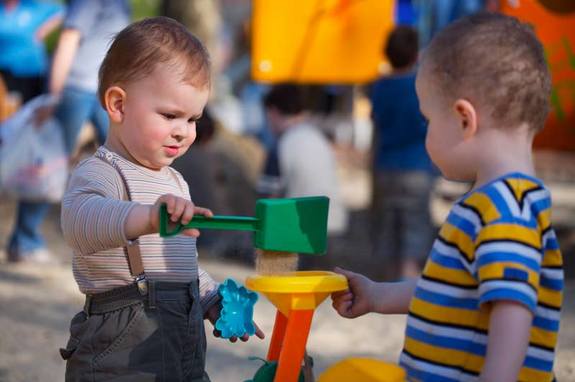Do Babies Have a Moral Compass? Debate Heats Up

An experiment five years ago suggested that babies are equipped with an innate moral compass, which drives them to choose good individuals over the bad in a wooden puppet show. But new research casts doubt on those findings, demonstrating that a baby's apparent preference for what's right might just reflect a fondness for bouncy things.
The researchers who conducted the original study stand by their results and interpretations, pointing to some discrepancies in the new study.
In the original study, conducted by Yale researchers in 2007, groups of 6-month-olds and 10-month-olds watched a puppet show with neutral wooden figures, where one figure, the climber, was trying to get up a hill. In one scenario, one of the other figures, called the helper, assisted the climber up the hill. In the other scenario, a third figure, called the hinderer, pushed the climber down.
Babies were then presented with the helper and hinderer figures so they could pick which one they preferred, and 14 out of 16 babies in the older group (10 months old) and all 12 of the 6-month-olds picked the helper. The study, which was published in the journal Nature, seemed to imply that infants could be good judges of character. [In Photos: How Babies Learn]
But researchers in New Zealand, who reviewed videos of the Yale experiments, say they noticed two other factors that could have driven the infants' choices.
"On the help and hinder trials, the toys collided with one another, an event we thought infants may not like," lead researchers Damian Scarf said in a statement from New Zealand's University of Otago. "Furthermore, only on the help trials, the climber bounced up and down at the top of hill, an event we thought infants may enjoy."
Scarf and his team, who detail their research online Aug. 8 in the journal PLoS ONE, conducted experiments to test these assumptions, with their results suggesting these visual elements were driving babies' choices of the helper over the hinderer.
Sign up for the Live Science daily newsletter now
Get the world’s most fascinating discoveries delivered straight to your inbox.
"For example, when we had the climber bounce at the bottom of the hill, but not at the top of the hill, infants preferred the hinderer, that is, the one that pushed the climber down the hill," Scarf explained. "If the social evaluation hypothesis was correct, we should have seen a clear preference for the helper, irrespective of the location of the bounce, because the helper always helped the climber achieve its goal of reaching the top of the hill."
In a response, also published online in PLoS ONE, the scientists who carried out the original 2007 study suggest the new study doesn't negate their baby-morality findings. One of their concerns involves the methods used by Scarf's team, which the researchers led by J. Kiley Hamlin, now an assistant professor of psychology at the University of British Columbia, say diverged from their own in critical ways.
For instance, the climber's gaze is usually pointed downward, unlike that in the Hamlin experiments, confusing the intended goal, which is to climb upward. Also, the during the helping events, the climber resumes its ascent before being contacted by the helper, "as if able to climb the hill on its own," Hamlin and colleagues write, adding, "Finally, and most strangely, during the Hindering events, the Climber starts to move downwards before the Hinderer makes contact, further clouding its intended goal."
These discrepancies would seem to make it tricky for infants to know that the climber needed help, and if they did, for them to know that the helper was helping. As such, it's possible the infants in the new study looked to these other variables (collisions and bounces) to make their decisions, Hamlin suggests.
Even if flaws did exist in their study, Hamlin and her colleagues point to various independent studies, one of which uses a similar setup without the "bouncing" of the climber, that support the "babies have a moral compass" theory. The researchers go on to note they have replicated their findings, that infants prefer prosocial others, in a range of social scenarios that don't include climbing, colliding or bouncing. Hamlin's other studies have shown babies are good judges of character.
Follow LiveScience on Twitter @livescience. We're also on Facebook & Google+.










